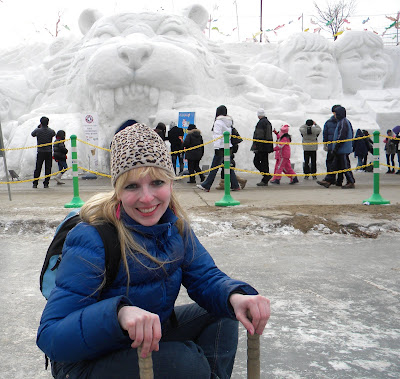
The Hwacheon (trout) Ice Festival comes once a year in Korea, a time when the otherwise sleepy little town of Sancheoneo bursts into life, all its fences, posts, buildings, and scenery ablaze with brightly coloured paper trout which, rather spectacularly -- if oddly -- all light up as night encroaches.
Yonsei University, where I work as an editor and proofreader extraordinaire, holds a summer and winter English camp for children. As the American and Canadian teachers often buzz in and out of the offices where I work, I happened to hear some of them mention going to an ice festival that upcoming weekend. "Me, too," I said. (I had actually never heard of said festival up to this point, but living abroad tends to make you leap on opportunity.)

So that weekend, after several hours in a bus that bumped and gurgled its way up icy mountain roads, we arrived in the small town of Sancheoneo, nestled protectively in a hollow between the base of several mountains. The Bukhangang River originates in this area, and, in the heart of winter, it freezes solid. The local people depended on the Bukhangang River for their livelihood in years past. Now, the festival's activities center around the river and it serves largely as a tourist attraction for urban Koreans who want to spend their free time in the country. Sancheoneo has become so famous for icefishing that it apparently runs out of trout, and purportedly, town officials hire workers to sneak to the river's edge at night and replenish the fish.

(Are these people taking out some fish or sneaking some in?)

By the time we arrived, around noon, there were certainly enough people camping out on the ice to make the rumors of stocking the river seem plausible, if not definite. The icy river had more holes cut through it than swiss cheese, but the ice was strong and thick and the air tangy with chill, so there was little danger of falling through.

Though there were nearly 100 people perched hopefully by little holes in the ice, some of the more experienced fishers told us it was too late to catch anything at this time of day. One raucous, exuberantly-friendly Korean man, Peter, invited us to share the fish he'd caught earlier that day. We were hesitant to take too much of his food -- he had his wife and children with him -- but the scent of the fresh-caught fish rolled off it in steamy little waves as it roasted over the grill and we took tiny white flakes of it with our chopsticks and delicately nibbled at those morsels.

After finishing eating and drinking with Peter (we, at least, managed to contribute the drinks), we entered the gaping, fanged mouth of a white tiger. The tiger was, of course, made of snow. Inside the tiger's belly was a long tunnel and several small rooms made entirely of ice and backlit in blue and green lights so that it had the outlandish atmosphere of a night club, albeit the world's chilliest night club.


Following this, our group separated somewhat, scattering on the ice as we found the section of the river that had been portioned off for ice sledding. Several members of our group played on a large, multi-person sled. As for myself, I rented one of the tiny ice sleds. It was just a small, square wooden board with a set of blades on the bottom, such as you might find on ice skates. Following the example of countless children and adults around me, I sat crosslegged on my new vehicle and used the two icepicks I'd been given to dash into the ice and then propel myself forward.

From my vantage point of the ice sled, I discovered many things to see at the festival, including the results of a creative sled-building contest, which had resulted in sleds made to look like tigers, tomatoes, and sea gulls.

I also noticed a trail where children could rent teddy bear rickshaws. It entertained me greatly to see the little mechanical bears jerk their rickshaws up and down the road, often abruptly halting, their tiny feet impotently moving in place, as they found no traction on the iced trail.

In the evening, our small group reunited, perhaps called out by Jonathan, who somehow convinced the man in charge of the loudspeakers (which reached almost the entire festival) to let him perform a brief karaoke dedicated to English teachers. And then, just when we thought the trip couldn't get any better, we discovered human bowling.

Finally, it was time to go home, with an odd constellation of paper fish lighting our way.




